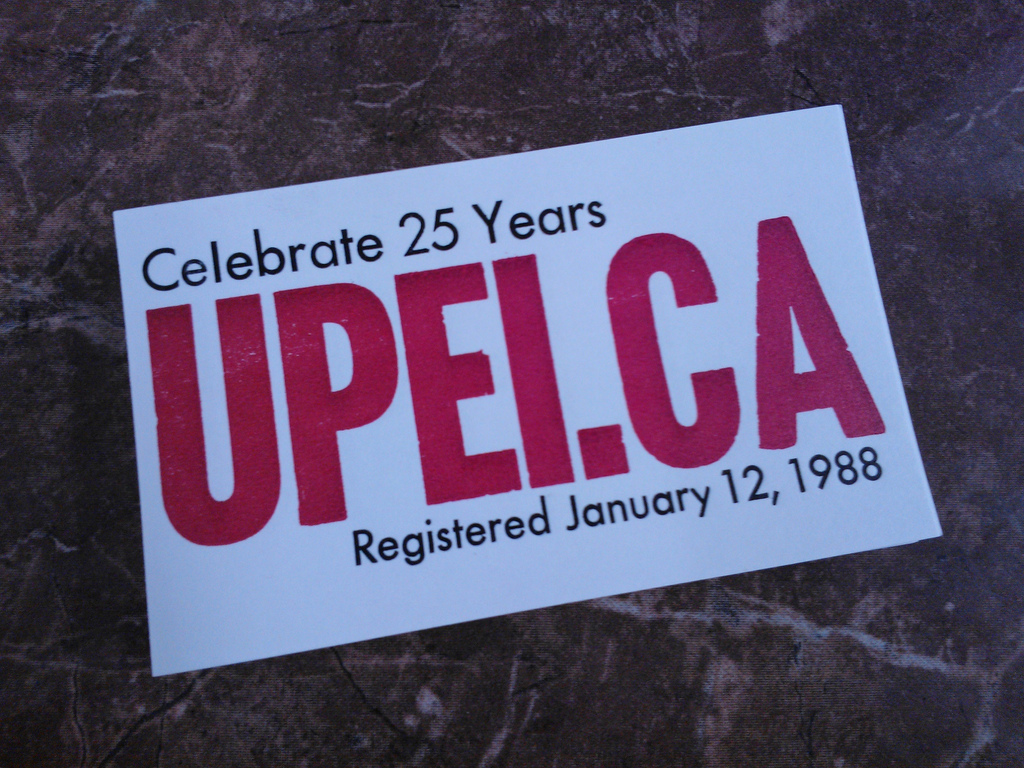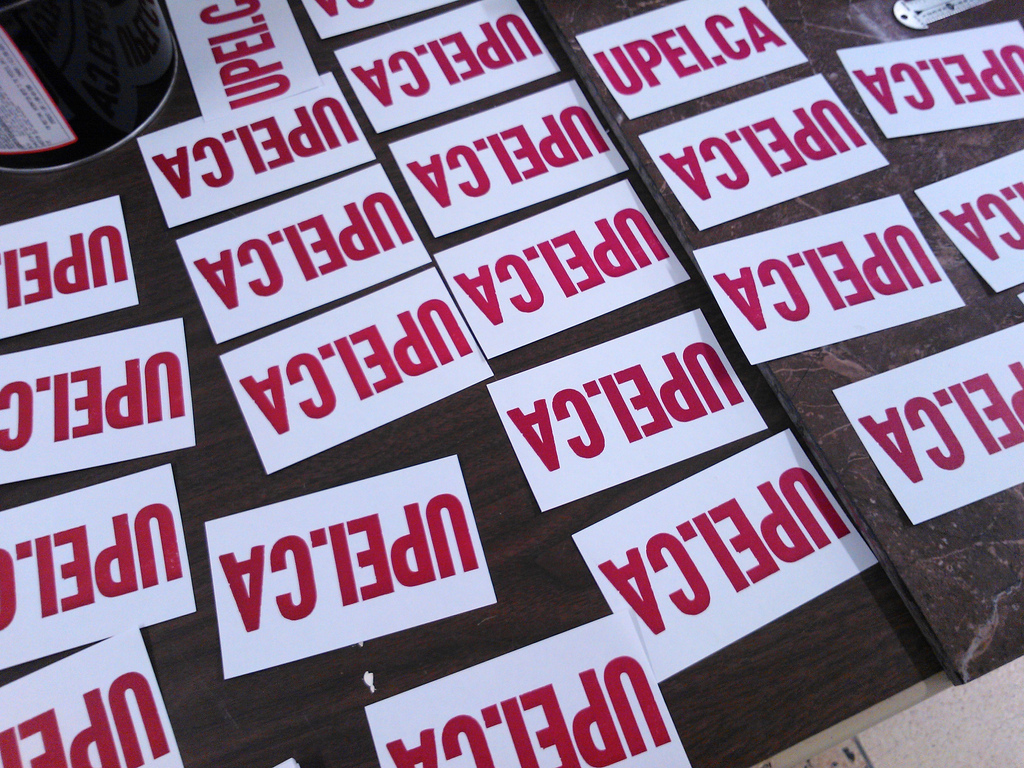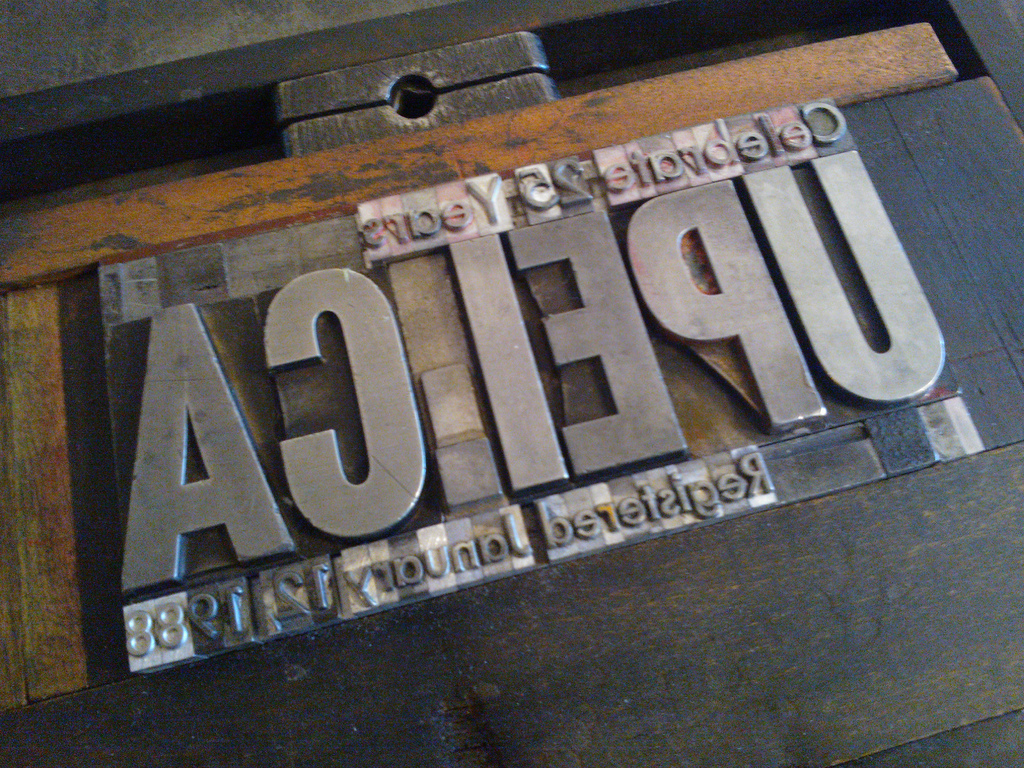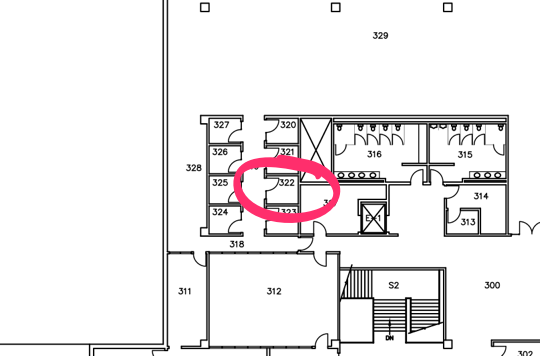Former Director of Computer Services at the University of PEI, Jim Hancock, appeared on Island Morning today to talk about the 25th anniversary of the upei.ca domain.
IslandNewspapers.ca, and particularly its digitizing of archival issues of The Charlottetown Guardian, is one of my favourite projects of Robertson Library, partly because I find it incredibly useful (especially in the about-to-be-released version that contains many more issues of the newspaper), and partly because the project first took root in a conversation I had with Mark Leggott, University Librarian, back in 1994 (an event memorialized in my Working for Free talk).
As proof-positive that projects like this take a long time to germinate, here’s a post from November 17, 1994 – 19 years ago! – where I asked the readers of the comp.text Usenet group for the lay of the digitization land:
I’m interested in hearing from anyone who knows anything about converting microfilmed archival newspapers and converting them to digital information through some sort of optical character recognition process.
All these years later, thanks to the hard work and dedication of many people who aren’t me, this project has come to fruition, and it will soon be possible to browse almost any historical issue of The Guardian from the comfort of your couch (to say nothing of the myriad research possibilities afforded by the ability to search the archive).
It’s interesting to look at the headers of the original source of that comp.text posting:
Path: nntp.gmd.de!xlink.net!howland.reston.ans.net!spool.mu.edu!torn! \ news.unb.ca!upei.ca!peinet.pe.ca!peinet.pe.ca!not-for-mail From: peicr...@bud.peinet.pe.ca (PEI Crafts Council) Newsgroups: comp.text Subject: OCR from microfilm: how? Date: 17 Nov 1994 12:01:42 -0400 Organization: PEINet Inc, Charlottetown, PEI Canada Lines: 9 Message-ID: <3afup6$2ah@bud.peinet.pe.ca> Reply-To: i...@crafts-council.pe.ca NNTP-Posting-Host: bud.peinet.pe.ca X-Newsreader: TIN [version 1.2 PL2]
From there we can learn some interesting historical tidbits:
- My email address at the time was peicraft@bud.peinet.pe.ca, as the PEI Crafts Council, where I was working, used PEINet’s email service at the time. The machine name “bud” was one I knew well, as it later went on to be the home of the first iterations of the www.gov.pe.ca website.
- Usenet was a “store and forward” network: you sent a message to your local network, which sent it “upstream,” in this case from PEINet to the University of Prince Edward Island, to the University of New Brunswick, to the University of Toronto (torn), to Marquette University in Milwaukee, through ans.net and xlink.net to nntp.gmd.de, a host at an institution that, apparently, no longer exists.
- I was using the Usenet “newsreader” software called “tin” (which is still around today; indeed you can download an archive of the same version 1.2 PL2 that I was using).
After a good afternoon on campus yesterday afternoon, I’ve been doing a little work around the edges from my downtown office.
- I got my authorization from IT Support & Services for VPN access to my virtual server. The instructions they provided for setup on Mac OS X were clear and concise, and worked without issues: connecting is now as simple as setting up a VPN tunnel via Tunnelblick and then SSHing in as I normally would to a remote host.
- I did a little aesthetic finessing on this site, installing the Premium Responsive theme to experiment with and throwing together a preliminary visual identity for the Hacker in Residence project (aided by the Integrated Communications Visual Identity Download Centre).
- Used Integrated Communications’ business card ordering site to order some Hacker in Residence business cards; then asked for permission to order business cards (and offered to pay the $60 cost myself if permission wasn’t granted; fortunately, it was).
- Ran into some issues with the virtual server and permissions: I wasn’t able to create files in my home directory (/home/prukavina), which meant that I couldn’t set up passwordless SSH authentication. Contacted Peter Lux at Robertson Library Systems and he corrected some issues with mounts to make it work.
- In response to my query to Chartwells about the lack of espresso on campus received a helpful reply: Currently there is no espresso machine on campus, but we have one on order with Vanhoutte, it will be put in Samuels sometime next month. I hope against hope that they’re talking about a bona fide coffee machine, and not a “cappuccino in a box” Irving gas station-style instant coffee maker.
- Finally, last night I went out to Staples and bought another trusty Microsoft Natural Ergonomic Keyboard 4000 for my UPEI office: I couldn’t handle another day of typing on my tiny MacBook Air keyboard. Also picked up a 32GB Lexar USB stick (on sale for $19.99) to let me use the various USB-stick-requiring devices in the library.
My second afternoon on campus.
- Picked up a key to room 322 from the Facilities Management across campus; very friendly and efficient service there.
- Tried out my campus card on the Shipping & Receiving door at the back of Robertson Library and confirmed that it works, so I can get 24/7 access to the library now.
- Found that the Ethernet jack on room 322 (labelled B-2-28) isn’t working; sent in a request to have this looked at. Will use the wifi, which just barely stretches in here, for the time-being.
- Got myself a PIN so that I could using the Campus Login system to change my campus network password.
- Talked to Peter Lux about getting a virtual server set up and he sprang into action and got me set up with a nice Drupal 7 installation (which is where I am typing now).
- Walked around campus handing out and posting cards marking the 25th anniversary of UPEI.ca’s registration. Met Blair Vessey for the first time face-to-face, and dropped in on Integrated Communications.
- Did a tiny bit of configuration on this Drupal installation, which I’ve pegged to hack.ruk.ca while awaiting an official upei.ca subdomain.
One of the unsung aspects of the University of Prince Edward Island is its pioneering involvement in the early Internet: under the leadership of Jim Hancock (Director of Computer Services from 1972 to 1997), UPEI, among other things, participated in the NetNorth, CA*Net and CANARIE initiatives, hosted Prince Edward Island’s first connection to the Internet, and registered the country’s first “.ca” domain, upei.ca, in 1988.
The upei.ca domain name registration’s anniversary is coming up on Sunday: 25 years ago, on January 12, 1988, the domain was registered with John Demco at the University of BC, a name well-known to any of us involved in the early Internet in Canada, as he was the go-to guy for all .ca domain name registrations for many years (back when they were free, but encumbered by many restrictions; that’s how I ended up, for a time, with the domain name digitalisland.kingston.pe.ca).
While the university’s work in this regard had tremendous benefits for the institution itself, it benefited Prince Edward Island as a whole in many other ways. In my case it made for my first contact with PEI when I was applying for a job here – an email from Morley Pinsent using the CA*Net email system hosted by UPEI that was free to any Islander who asked – and, once I relocated here, it was my conduit to the greater world through my email address caprukav@atlas.cs.upei.ca (I still remember the day in 1993 when, as a meek 27 year old, Earlene Gallant handled the paperwork to sign me up for this).
UPEI’s work led to PEINet, which became (via a 14.4 kbps leased line connection) the conduit for the first webserver on PEI, at the PEI Crafts Council, to join the network; later, it was on PEINet’s web host that I created the first versions of www.gov.pe.ca. Through this all, the counsel of Jim’s successor as Director of Computer Services, Dave Cairns, was extremely valuable (the best piece of advice Dave ever gave me: hard drives will always fail, eventually, and maybe tomorrow).
All Islanders owe a great debt to the University of PEI for its vision in this regard; to help mark the occasion, I printed up a ceremonial poster on the letterpress this afternoon, and I’ll stick them up around town and campus over the next few days:



I began a new appointment today, as Hacker in Residence at Robertson Library, University of Prince Edward Island. Under the aegis of the university’s “visiting scholar” program, I’ll be a part-time member of the library community for the next year, with a mandate:
To bring the spirit and application of the ‘hacker ethic’ to the Robertson Library where the hacker ethic is defined as “access, freedom of information, and improvement to quality of life.”
That’s intentionally open-ended: while I have a grasp of the terrain I’d like to wander, what I’ll be doing specifically is to be seen. In general, I’ll be seeking to take the infrastructure, facilities, systems and special projects of the library apart and shed light on them by remixing, mashing-up, communicating and enlivening. I will be a “user in residence,” “patron in residence,” and “developer in residence” by times (and no, I will have nothing to do with “testing the library’s security systems,” which reflects a different (mis)use of the term “hacker”).
The appointment has its roots in conversations that University Librarian Mark Leggott and I started having when he was first appointed 6 years ago: I’ve long sought a way of becoming more deeply engaged with the work the library is doing, and it took 6 years for us to hack together a model that worked. In innumerable ways, it’s a dream position for me.
My role isn’t operational – which is good, because I’m not getting paid! – and has no specific research goals. If that sounds an awful lot like “hanging out around the library and doing stuff I find interesting,” that’s good, because that’s what I’m planning on doing. Beyond scratching my personal interests and and curiousities, I’m a strong believer that a hacker presence inside any organization can be a force for good, and this is a good opportunity to put that belief to the test.
I’ll be on the University of PEI campus two or three times a week, working out of tiny room 322 of Robertson Library on the second floor beside the stacks, 50 square feet of highly-concentrated hackerspace that, right now, has a desk chair and an Ethernet jack waiting for me. Some time later this week there will be a website attached to me, where various reports of my exploits will begin to flow.
A brief summary of day one’s activities:
- Sampled the cinnamon-raisin bagels of the in-library café, a facility that, alas, does not serve espresso-based beverages (a coffee drought that afflicts the entire campus, it seems) and met the friendly café staff (man does that place get busy between classes!).
- Got a tour of the library, and introductions to most of the staff, from the ever-helpful and efficient Pauline MacPherson, library administrator.
- Met briefly with Peter Lux, a colleague from many projects in the past, to get a general lay of the systems and to talk about getting a virtual server set up for me.
- Met briefly with Don Moses, another longtime colleague and now Digitization Initiatives & Systems head at the library, about the general lay of his land.
- Took the measurements of my office (92” x 80” with a 92” x 25” counter/desk, a bookshelf, a single electrical outlet, a single Ethernet port, a wastepaper basket and a bulletin board).
- Make a request from Special Collections Librarian Simon Lloyd for blueprints of the library building (not currently in the collection, but perhaps available from the facilities branch of the university); figured a good way to start my term was to get a handle on the physical plant at the same time as I’m checking out the digital plant.
- Got myself hooked up to the wifi (only the barest dribble of a signal in my office, which I’ll have to fix somehow).
- Tracked down the history of Robertson Library.
- Bought a 10-pack of bus tickets to get me to and from the library.
Various bits of paperwork and bureaucracy are still in the works: security needs to cut me a key to my office and arrange for 24/7 access via the back door (so I can host raves, etc.), computer services needs to rejig my campus account so I can do things like print and access server resources. But, otherwise, I’m ready to roll.
A brief summary of day one’s activities:
- Sampled the cinnamon-raisin bagels of the in-library café, a facility that, alas, does not serve espresso-based beverages (a coffee drought that afflicts the entire campus, it seems) and met the friendly café staff (man does that place get busy between classes!).
- Got a tour of the library, and introductions to most of the staff, from the ever-helpful and efficient Pauline MacPherson, library administrator.
- Met briefly with Peter Lux, a colleague from many projects in the past, to get a general lay of the systems and to talk about getting a virtual server set up for me.
- Met briefly with Don Moses, another longtime colleague and now Digitization Initiatives & Systems head at the library, about the general lay of his land.
- Took the measurements of my office (92” x 80” with a 92” x 25” counter/desk, a bookshelf, a single electrical outlet, a single Ethernet port, a wastepaper basket and a bulletin board).
- Made a request from Special Collections Librarian Simon Lloyd for blueprints of the library building (not currently in the collection, but perhaps available from the facilities branch of the university); figured a good way to start my term was to get a handle on the physical plant at the same time as I’m checking out the digital plant.
- Got myself hooked up to the wifi (only the barest dribble of a signal in my office, which I’ll have to fix somehow).
- Tracked down the history of Robertson Library.
- Bought a 10-pack of bus tickets to get me to and from the library.
I am one of those “never quite got the hang of electronics” kids. Sure, I built myself a crystal radio. Got that drugstore prescription printer to work with my TRS-80 Model I. And I’ve wired up my share of connectors and cables. But soldering was always a roadblock. And don’t get me started on decrypting the coloured bands on resistors. It’s not that any of this was particularly impenetrable; it’s just that I never took the time, perhaps because sticking to software allowed me to do much more delightful things. But, now I’ve got a Raspberry Pi, and we’re in the Internet of Things era, so the least I can do is get some LEDs turning on and off with Python.
I used this tutorial as the basis for my coding – I just stripped out the IMAP-checking bits; the code looks like this:
import RPi.GPIO as GPIO GPIO.setmode(GPIO.BCM) GREEN_LED = 18 RED_LED = 23 GPIO.setup(GREEN_LED, GPIO.OUT) GPIO.setup(RED_LED, GPIO.OUT) GPIO.output(GREEN_LED, True) GPIO.output(RED_LED, True)
Can a “are we getting more than 100% of our electricity from the wind” alert system be too far behind?
Twenty years after I first installed Linux (on an IBM PS/2), I booted up a tiny deck-of-cards-sized Raspberry Pi here in the lab. It was dead simple to get running. And, once running, feels like coming home.

The British series The Hour, a period drama set in the 1960s in and around a current affairs program at the BBC. My favourite design element of the series are the title credits:
What I particularly like is that the visual metaphor of the credits is echoed in the design of the offices inside The Hour: the windows are covered with a lattice that shares the same design:

You can watch The Hour in Canada on Netflix, where two complete seasons are now available.

 I am
I am